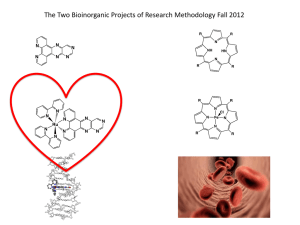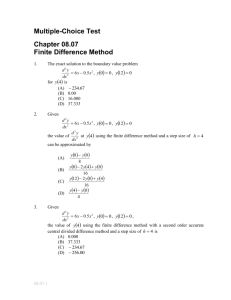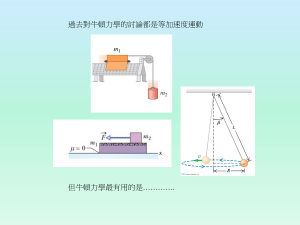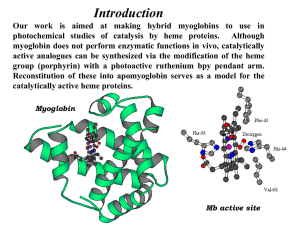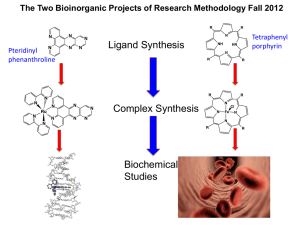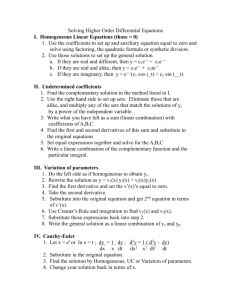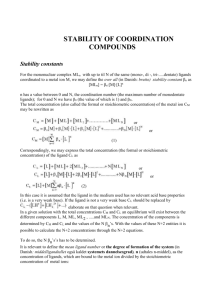Chapter 6: Electronic and Electrochemical Properties of
advertisement
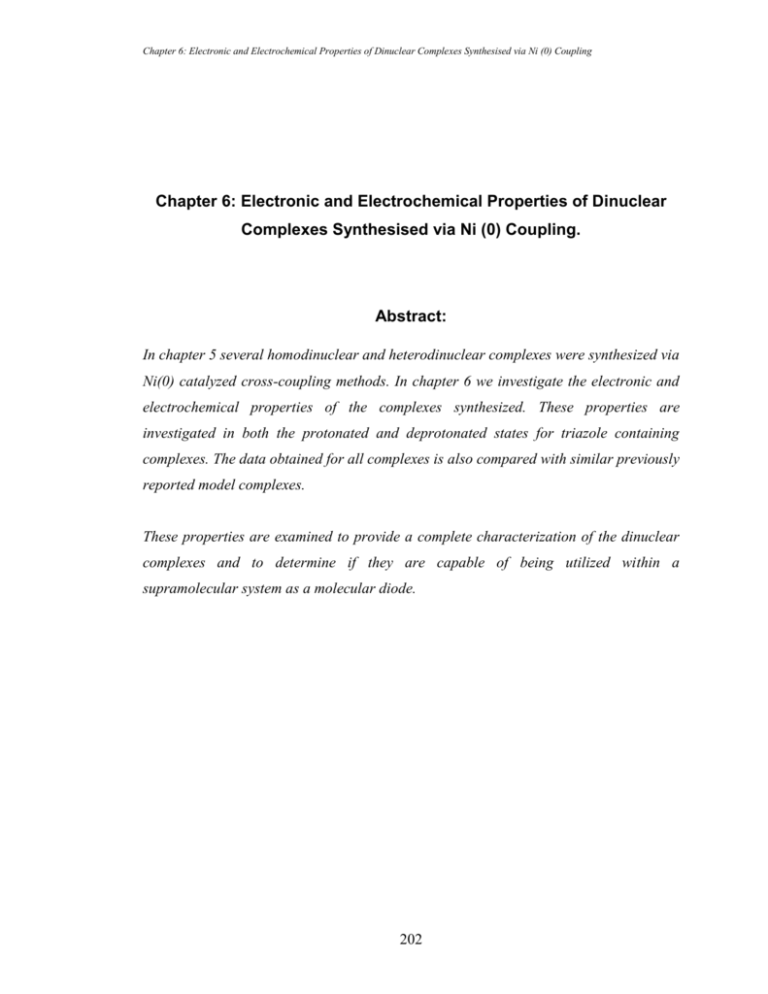
Chapter 6: Electronic and Electrochemical Properties of Dinuclear Complexes Synthesised via Ni (0) Coupling
Chapter 6: Electronic and Electrochemical Properties of Dinuclear
Complexes Synthesised via Ni (0) Coupling.
Abstract:
In chapter 5 several homodinuclear and heterodinuclear complexes were synthesized via
Ni(0) catalyzed cross-coupling methods. In chapter 6 we investigate the electronic and
electrochemical properties of the complexes synthesized. These properties are
investigated in both the protonated and deprotonated states for triazole containing
complexes. The data obtained for all complexes is also compared with similar previously
reported model complexes.
These properties are examined to provide a complete characterization of the dinuclear
complexes and to determine if they are capable of being utilized within a
supramolecular system as a molecular diode.
202
Chapter 6: Electronic and Electrochemical Properties of Dinuclear Complexes Synthesised via Ni (0) Coupling
6.1 Introduction
As discussed in previous chapters, ruthenium based, and increasingly osmium based,
metal complexes have proved of particular interest in the development of
supramolecular systems1. Their photochemical, photophysical and electrochemical
properties are the basis of this interest and has lead to the widespread development and
investigation into their applications as artificial antenna systems 2, charge separation
devices for photochemical solar energy conversion
2
, molecular electronics3 and
information storage devices.4
Here we investigate the ground state and excited state interactions present in the
complexes synthesized in chapter 5. We firstly determine the ground state interactions
by examining the electrochemical properties of these complexes. Generally in bipyridine
based ruthenium metal complexes most interest stems from their redox properties.
Normally the initial oxidation involves a metal centered orbital, with formation of a
Ru(III) complex. However, these oxidation potentials tend to fall within a narrow range,
which may not be desirable for the relevant application. In spite of this, by substitution
of one or more of the bipyridine ligands with a different ligand system we may alter
these redox potentials thereby lowering the oxidation potential and increasing the
reduction potential or vice versa. The effect the varying types of bridging ligand systems
have on the redox properties of the metal complexes will be discussed in further detail in
section 6.2.3.
The redox potentials are also affected by the use of different metal ions within the
complex, such as an osmium rather than a ruthenium metal centre. By using only an
osmium metal center within a complex we will see an affect on the redox potential of the
compounds. To complete this discussion, lastly we investigate heterodinuclear
complexes with both a ruthenium and osmium metal ion present.
In the examination of the excited state interactions present the metal to ligand charge
transfer (MLCT) excited state, is the area of significance. For this reason we investigate
203
Chapter 6: Electronic and Electrochemical Properties of Dinuclear Complexes Synthesised via Ni (0) Coupling
both the absorption and emission spectroscopy of the metal complex of interest, as well
as their luminescence lifetimes. Once again the nature of the ligands and metal ions
present will determine the electronic properties of the complex overall. Also if possible
the location of the excited state may be examined using deuteriation and selective
deuteriation techniques5, 6, 7, 8, 9.
The excited state lifetimes are governed by the two major pathways for non-radiative
deactivation: (1) the energy gap law 10, 11 whereby the 3MLCT is very low in energy and
the excited state lifetime may be shortened by direct contribution back to the GS (ground
state) or (2) the gap between the emitting 3MLCT and the deactivating 3MC level, which
is a thermally accessible pathway back to the GS. By manipulating the energy gap
between the 3MLCT – 3MC of a particular complex it is possible to minimize the nonradiative decay through the 3MC level to the ground state. This can be achieved by
destabilization of the 3MC state or stabilization of the 3MLCT state to generate a greater
energy gap between the two states. However care must be taken as stabilization of the
3
MLCT state also reduces the energy gap between it and the GS, thereby facilitating
deactivation via the energy gap law.
4+
(bpy)2
Ru
N
N
C4
C4
N
N
Ru(bpy)2
Figure 6.1: Structure of the complex tris-(2,2’-bipyridine)ruthenium(II) directly coupled
at the C4 carbon.29
204
Chapter 6: Electronic and Electrochemical Properties of Dinuclear Complexes Synthesised via Ni (0) Coupling
There have also been previous reports of bis-bipyridine bridged ruthenium metal
complexes similar to complex 2. This complex, shown in figure 6.1, illustrates how the
bipyridine bridged is linked at the 4-position rather than the 5-position as is the case in
complex 2.29 This complex demonstrates a reversible one electron oxidation wave at
+1.22 V vs. SCE and three reversible reduction waves. The electronic properties of this
dinuclear complex are observed at an absorption maxima of 471 nm and 445 nm
corresponding to the d → π* 1MLCT transitions.29
This spectral and electrochemical data for the complex shown in figure 6.1 is compared
with that obtained for complexes 2, [Ru(bpy)2(bis-bpy)Ru(bpy)2]4+ and 8, [Os(bpy)2(bisbpy)Os(bpy)2]4+ and is discussed further in sections 6.2 and 6.3. The remaining
dinuclear complexes shall be compared with one another and with other model
compounds from table 6.1.
Of the additional dinuclear complexes to be discussed in this chapter complex 3
[Ru(bpy)2(pytr-pytr)Ru(bpy)2]2+ has been reported previously12. This triazole containing
ruthenium metal complex was synthesized via Ni(0) cross-coupling within this research
group in 2002. Direct comparison of the electronic and electrochemical properties of the
complexes synthesized from chapter 5 will be made with these previously reported
results.
As ruthenium bipyridine complexes generally display phosphorescence phenomena over
a wide temperature range, all absorption and emission spectroscopy in this chapter are
measured at room temperature. These spectra confirm the presence of MLCT bands,
which occur over a range of wavelengths depending on, of course, the metal centre,
either ruthenium or osmium and the nature of bridging ligands present. These transitions
are of most interest and the electronic properties of the novel complexes synthesized will
be discussed further in sections 6.2.1, along with investigations into their luminescence
lifetimes which will be detailed in section 6.2.2.
205
Chapter 6: Electronic and Electrochemical Properties of Dinuclear Complexes Synthesised via Ni (0) Coupling
4+
3+
N
N
N
N
N
N
N
Ru
N
N
N
N
N
Complex 1
Complex 2
N
N
Ru
3+
2+
N
N
N
Ru N
N N N
N
N
N
N
N
N
N
N
N
N
N
N
N
N
N
N
N
N
Ru
N
N
N
Ru
N
N
Ru
N
N
N
N
Os
N
Complex 3
N
Ru
N
N
N
N
N
N
Complex 7
3+
4+
N
N
N
Os
N
N
N
N
N
N
N
N
N
Os
N
N
N
N
Ru
N
N
Complex 8
N
N
Os
N
N
N
N
N
N
Complex 9
N
2+
N
N
Os
N
N N N
N
N
N
N
Os
N
N
N
N
N
Complex 10
Figure 6.2: Structure of compounds 1-3 and 7-10 to be discussed in this chapter. Complexes 4, 5
and 6 are the deuteriated analogues of 1,2 and 3, and are not shown here.
206
Chapter 6: Electronic and Electrochemical Properties of Dinuclear Complexes Synthesised via Ni (0) Coupling
6.2 Electronic Properties of Novel Dinuclear Complexes
The electronic properties of the novel complexes 1 – 10 are detailed in table 6.1, along
with the model compounds [Ru(bpy)3]2+ and [Os(bpy)3]2+. All the absorption and
emission spectra were recorded using spectroscopic grade acetonitrile and carried out at
room temperature. The spectrum of each complex is shown in figures 6.3 – 6.8 also.
Absorption
Emission
τ (ns)
ε
(nm)
(nm)
aerated
(104 M-1cm-1)
447
668
82
0.88
440
663
217
2.53
478
686
62
1.90
447
668
92
NA
440
663
225
NA
478
686
66
NA
445, 622
738
49
1.23, 0.16
470, 625
780
83
2.57, 0.47
[Os(bpy)2(pytr-bpy)Ru(bpy)2]3+
449,
808
89
1.68, 1.18
(Complex 9)
510(shoulder)
496, 652
811
13
2.67, 0.61
[Ru(bpy)3]2+
450
615
800
1.30
[Os(bpy)2]3+
468
732
62
1.11
Complex
[Ru(bpy)2(pytr-bpy)Ru(bpy)2]3+
(Complex 1)
[Ru(bpy)2(5-bisbpy)Ru(bpy)2]4+
(Complex 2)
[Ru(bpy)2(pytr-pytr)Ru(bpy)2]2+
(Complex 3)
[Ru(d8-bpy)2(pytr-bpy)Ru(d8-bpy)2]3+
(Complex 4)
[Ru(d8-bpy)2(5-bisbpy)Ru(d8-bpy)2]4+
(Complex 5)
[Ru(d8-bpy)2(pytr-pytr)Ru(d8-bpy)2]2+
(Complex 6)
[Ru(bpy)2(pytr-bpy)Os(bpy)2]3+
(Complex 7)
[Os(bpy)2(5-bisbpy)Os(bpy)2]4+
(Complex 8)
[Os (bpy)2(pytr-pytr)Os(bpy)2]
2+
(Complex 10)
Table 6.1: Electronic properties of complexes 1-10, along with model complexes [Ru(bpy)3]2+
and [Os(bpy)3]2+ as measured in CH3CN. All complexes are in their fully deprotonated state.
207
Chapter 6: Electronic and Electrochemical Properties of Dinuclear Complexes Synthesised via Ni (0) Coupling
The bands which are of most interest in these complexes are the d* metal to ligand
charge transfer bands. These intense bands have molar absorptivities (ε) typically in the
range of 104 M-1cm-1. The position of these bands provides information about the
electronic structure of the complex.13 The presence of strong -donating ligands results
in increased electron density on the ruthenium or osmium centre causing the MLCT (t2g
- *π) transition to be shifted to the red (i.e. to lower energy)14. Related ruthenium
complexes of imidazole, benzimidazole and triazole ligands have absorption spectra
whose 1MLCT bands have been shifted to lower energy due to the -donating properties
of the ligands.15, 16, 17
Conversely the presence of π-acceptor ligands results in the MLCT transition being blue
shifted due to a stabilization of the metal d orbitals (t2g), as is the case with the presence
of ligands such as 2,2’-bpyridine, 2,2-bipyrimidine and 1,10-phenanthroline. Although
these systems generally lead to the 3MLCT being observed at higher energy the
luminescent lifetimes tend to be longer due to the large energy gap between the 3MC and
ground state (GS), the emitting state. The complexes (1- 10) reported here involve a
mixed ligand system with both π-acceptor and σ-donor ligands present.
Deuteriation of the ligands is not expected to have an effect on either the position or the
intensity of the MLCT transitions occurring in the ruthenium and osmium complexes.18
The molar absorptivities of the deuteriated complexes have not been measured as they
should be the same as for the undeuteriated complexes. Deuteriation was carried out in
an effort to investigate the location of the excited state within complexes 1 – 10 and
shall be discussed in further detailed later in this section.
208
Chapter 6: Electronic and Electrochemical Properties of Dinuclear Complexes Synthesised via Ni (0) Coupling
3+
[Os(bpy)2(pytr-bpy)Ru(bpy)2]
1.0
3+
[Ru(bpy)2(pytr-bpy)Os(bpy)2]
3+
[Ru(bpy)2(pytr-bpy)Ru(bpy)2]
0.8
Intensity
0.6
0.4
0.2
0.0
200
400
600
800
Wavelenght (nm)
Figure 6.3: Absorption spectra of novel dinuclear complexes 1-3
4+
[Os(bpy)2(bis-bpy)Os(bpy)2]
2+
1.0
[Os(bpy)2(pytr-pytr)Os(bpy)2]
4+
[Ru(bpy)2(bis-bpy)Ru(bpy)2]
2+
[Ru(bpy)2(pytr-pytr)Ru(bpy)2]
0.8
Intensity
0.6
0.4
0.2
0.0
200
400
600
800
Wavelenght (nm)
Figure 6.4: Absorption spectra of novel dinuclear complexes 7-10
209
Chapter 6: Electronic and Electrochemical Properties of Dinuclear Complexes Synthesised via Ni (0) Coupling
All the compounds shown in figures 6.3 and 6.4 have intense absorption bands in the
visible region between 300 - 390 nm and 420 - 520 nm. These may be attributed to the π
– π* intra-ligand transitions associated with the bpy and bridging ligands, and dπ – π*
metal to ligand charge transfer (1MLCT) transitions, respectively.
As can be observed from table 6.1 the [M(bpy)2(5bis-bpy)M(bpy)2]4+ type complexes,
were M = Ru / Os, show very similar absorption maxima to the model compounds
[Ru(bpy)3]2+ and [Os(bpy)3]2+. The complexes [Os(bpy)2(5bis-bpy)Os(bpy)2]4+ (complex
8) and [Ru(bpy)2(5bis-bpy)Ru(bpy)2]4+ (complex 2) absorb at 463 nm and 440 nm
respectively, which is within 5 – 10 nm of the parent compounds. This is an expected
observation as the structures of the novel complexes 2 and 8 are akin with those of
[Ru(bpy)3]2+ and [Os(bpy)3]2+. The slight shift to higher energy of the dinuclear
complexes 2 and 8 may be due to the greater delocalization across the bridging ligand
which has the affect of a small increase in its π-acceptor ability. These absorption bands
at 463 nm and 440 nm are associated with a spin allowed 1MLCT transition. It is also
observed that upon replacing a ruthenium containing unit with an osmium unit there is a
shift to lower energy. This may be attributed to the higher energy of the 5d orbitals of
osmium compared with the 4d orbitals of ruthenium.
Secondly we also observe an additional absorption band at 625 nm for complex 8. This
band is associated with a formally forbidden dπ – π* (3MLCT) transition. This is a
charge transfer band and occurs whenever the ligand acceptor orbitals and metal orbitals
overlap appropriately. This increase in spin-orbit coupling results in a greater mixing of
the singlet and triplet states and a breakdown in the selection rules prohibiting changes
in multiplicity. This is the case for the majority of osmium complexes discussed within
this section, so we will observe a second MLCT transition above approx: 500 nm in
these spectra.
By changing the bridging ligand from a symmetrical (bis-bpy) to an asymmetrical (pytrbpy) we observe a general shift to lower energy of approx: 7 – 10 nm. This is due to the
replacement of a strong π-accepting ligand in the form of bipyridine with a strong σ-
210
Chapter 6: Electronic and Electrochemical Properties of Dinuclear Complexes Synthesised via Ni (0) Coupling
donating ligand in the form of pyridine-triazole. Ligands with σ-donor properties donate
electron density into the metal centre causing a reduction in the t2g-π* energy gap.
Consequently the MLCT – GS gap is reduced and the absorption will move to lower
energy. In the case of complexes 1, 7 and 9 we observe a relatively small shift to lower
energy of approx: 5 – 10 nm.
As noted above those complexes with osmium metal centres present exhibit an
additional band, at 622 nm for [Ru(bpy)2(pytr-bpy)Os(bpy)2]3+ (complex 7) and 510 nm
for [Os(bpy)2(pytr-bpy)Ru(bpy)2]3+ (complex 9) respectively. These are attributed to
forbidden transitions to the triplet state and are due to the increased spin orbit coupling
caused by the osmium.
Finally when examining metal complexes with the symmetrical bis(pyridine-triazole)
bridging ligand (complexes 3 and 10) we observe a further red shift in the absorption
maxima. This is once again due to the presence of two very strong -donor ligands,
whose donation of electron density into the metal centres reduces the t 2g-π* energy gap.
The shift to lower energy is in the order of 30 nm for each complex. This is a greater
overall shift to lower energy compared with the asymmetrically bridged metal
complexes. This may be due to the presence of two σ-donor ligands, rather than just one
as was the case previously, resulting in a increased overall donation of electron density
into the metal centres and a greater reduction in the t2g-π* energy gap. The complex
[Os(bpy)2(pytr-pytr)Os(bpy)2]2+ demonstrates the formally forbidden MLCT transition
at 652 nm.
The absorption spectra of the complexes 1-10, demonstrated the expected transitions and
are red shifted in accordance with previously reported compounds upon substitution of
the bridging ligand with a better σ-donor ligand.19 Figure 6.5 – 6.6 show the emission
spectra of complexes 1-10, with their emission maxima detailed in table 6.1
211
Chapter 6: Electronic and Electrochemical Properties of Dinuclear Complexes Synthesised via Ni (0) Coupling
4+
[Ru(bpy)2(bis-bpy)Ru(bpy)2]
3+
[Ru(bpy)2(pytr-bpy)Os(bpy)2]
3+
[Ru(bpy)2(pytr-bpy)Ru(bpy)2]
100
Intensity
80
60
40
20
0
500
550
600
650
700
750
800
850
900
Wavelenght (nm)
Figure 6.5: Emission spectra for complexes 1, 2 and 7.
[Os(bpy)2(pytr-pytr)Os(bpy)2]
[Os(bpy)2(pytr-bpy)Ru(bpy)2]
8
2+
3+
[Ru(bpy)2(pytr-pytr)Ru(bpy)2]
2+
4+
[Os(bpy)2(bis-bpy)Os(bpy)2]
Intensity
6
4
2
0
500
550
600
650
700
750
800
850
900
Wavelenght (nm)
Figure 6.6: Emission spectra of complexes 3, 8, 9 and 10.
All ten complexes exhibit luminescence at room temperature which originates from the
3
MLCT. 20 As observed for the absorption spectra there is a general shift to lower energy
212
Chapter 6: Electronic and Electrochemical Properties of Dinuclear Complexes Synthesised via Ni (0) Coupling
of the emission maxima as we increase the number of σ-donor ligands present in the
bridging ligand, i.e pyridine-triazole (pytr) ligands into the system. As explained above
this results in a reduction in the t2g-π* energy gap. Also noted above the initial
replacement of one of the π – acceptor bipyridines in the bridging ligand with a strong σ
– donor pyridine triazole ligand does not result in a large shift to lower energy. However
the presence of two pyridine triazole ligands in the bridging ligand results in a much
greater red shift, of the order of 30 - 40 nm.
The complexes [Ru(bpy)2(5bis-bpy)Ru(bpy)2]4+ (2) and [Os(bpy)2(5bis-bpy)Os(bpy)2]4+
(8) emit at 663 nm and 785 nm respectively. This is higher in energy when compared
with the other metal complexes due to the presence of approx: 6 π-acceptor ligands in
the form of 2,2’-bipyridine. These ligands stabilize the metal dπ orbitals. The emission
for complex 2 is similar to previous reports for an analogous (bis-bpy) bridged
complex.29 The emission of complex 2, which is bridged at the 5-position, is 663 nm. As
noted with the absorption spectra when replacing a ruthenium metal centre with an
osmium metal centre there is a further red shift of the 1MLCT due to the higher energy
of the osmium valence electrons compared with the ruthenium valence electrons.
The complexes [Ru(bpy)2(pytr-pytr)Ru(bpy)2]2+ (3) and [Os(bpy)2(pytr-pytr)Os(bpy)2]2+
(10) are luminescent at 686 nm and 811 nm. This lower energy emission is due to the
strong σ-donor properties of the two pyridine triazole system within the bridging ligand.
The emission observed for complex 3 is very similar to the previous reports for this
complex which occurred at 690 nm.12
Finally the observed emission maxima for the asymmetrically bridged complexes
[Ru(bpy)2(pytr-bpy)Ru(bpy)2]3+
(1),
[Ru(bpy)2(pytr-bpy)Os(bpy)2]3+
(7)
and
[Os(bpy)2(pytr-bpy)Ru(bpy)2]2+ (9) are 668 nm, 738 nm and 808 nm, respectively. The
emission of complex 1 falls between those observed for its symmetrically bridged
ruthenium analogues, complexes 2 and 3. The emission observed for complex 7 at 738
nm is closer in proximity to an [Os(bpy)3]2+ emission at 732 nm than a [Ru(bpy)2(pytr)]
emission at 650 nm.12 This suggests that the emission for complex 7 is osmium metal
213
Chapter 6: Electronic and Electrochemical Properties of Dinuclear Complexes Synthesised via Ni (0) Coupling
centre based. For complex 9 the observed emission of 811 nm is distinctive of an
osmium based emission and is not that of a [Ru(bpy)3]2+ based emission.
Having shown that the complexes emit at room temperature, the nature of this emitting
state was investigated. Deuteriation of the 2,2’-bipyridyl ligand and the subsequent use
of this deuteriated ligand to synthesis the mixed ligand complexes containing the various
ligands have allowed the nature of the emissive state to be determined. The syntheses of
the deuterated complexes are detailed in chapter 5. Deuteriation has been used as a tool
for the study of the photophysical properties of organic and inorganic systems since the
1960s.18 The effect of solvent deuteriation has been of most interest, but the effect of
ligand deuteriation has also been studied in order to increase lifetimes and improve the
quantum yield of complexes. In the area of supramolecular chemistry this has proved to
be very useful as often complex molecular assemblies are involved.
For aromatic compounds, both the S1 and T1 states are * in nature and therefore out
of plane C-H bending modes would be potential channels for radiationless decay.
Deuteriation reduces both the amplitude and the frequency of C-H vibrational modes
and therefore C-D vibrations are of a lower frequency and amplitude than the equivalent
C-H vibrations which results in an increase in the observed lifetime of the electronically
excited state. This is more pronounced for free aromatic compounds than for transition
metal complexes since the excited state of the complexes are generally more distorted
with respect to the ground state and hence lower frequency vibrational modes, such as
ring breathing, are more important. It was hoped therefore that a comparison of the
lifetimes of both the non-deuteriated complexes and the deuteriated complexes may
yield information as to the nature of the excited state. The result of this analysis is listed
in Table 6.1. Partial deuteriation in combination with the measurement of the excited
state lifetimes has been proposed as a method for the location of the emitting state of
heteroleptic ruthenium polypyridyl complexes.21 It has been suggested that deuteriation
of one of the ligands in a mixed ligand22 complex will only affect the emission lifetime
if the emitting state is based on that ligand.
214
Chapter 6: Electronic and Electrochemical Properties of Dinuclear Complexes Synthesised via Ni (0) Coupling
Complex
[Ru(bpy)2(pytr-bpy)Ru(bpy)2]3+
τ (ns)
τ (ns)
{± 2.5%}
{± 2.5%}
82
92
Complex
[Ru(d8-bpy)2(pytr-bpy)Ru(d8-bpy)2]3+
(Complex 1)
(Complex 4)
[Ru(bpy)2(5-bisbpy)Ru(bpy)2]4+
217
225
[Ru(d8-bpy)2(5-bisbpy)Ru(d8-bpy)2]4+
(Complex 2)
(Complex 5)
[Ru(bpy)2(pytr-pytr)Ru(bpy)2]2+
62
66
[Ru(d8-bpy)2(pytr-pytr)Ru(d8-bpy)2]2+
(Complex 3)
(Complex 6)
Table 6.2: Effect of deuteriation on emission lifetime of complexes 1 – 6 as measured in aerated
CH3CN with experimental error ± 2.5%.
It is expected that if the excited state of the complex is located on the (bpy) ligands
which are deuteriated the emission lifetime should increase. In comparing the nondeuteriated complexes (1 – 3) and the deuteriated complexes (4 – 6) we observe a
general increase in the emission lifetime by approx: 4 – 10 ns upon deuteriation which
ranges from an overall increase in lifetime of 4 % - 12 %. Previous reports utilizing
deuteriation techniques in the investigation of luminescent lifetimes noted that if the
excited state is located on the deuteriated ligand the lifetimes should increase by approx:
10 %.22, 23 Here we observe the luminescent lifetimes of complexes 1 and 3 increase by
10 % and 12 % respectively indicating their excited states may lie on the peripheral
deuteriated (bpy)’s. However in the case of complex 2 we observe only a 4 % increase in
the luminescent lifetimes upon deuteriation indicating that the excited state lies on the
(bpy) bridging ligand and not on the peripheral deuteriated (bpy) ligands.
However these results are by no means conclusive. In order to determine the exact
location of the excited state further more specific experiments, such as transient
resonance raman spectroscopy, must be carried out.
215
Chapter 6: Electronic and Electrochemical Properties of Dinuclear Complexes Synthesised via Ni (0) Coupling
6.2.1 Acid / Base Chemistry of the Dinuclear Complexes
In many of the dinuclear complexes synthesized there is the possibility of protonating
one of the triazole moieties. These changes in pH will affect the nature of the bridging
ligands, which will result in an alteration in the electronic properties of the complexes.
+
N
N
M
N
N
N
N
N
H
N
N
N
N
N
N
N
M
N
Complex 1 M1/M2 = Ru
Complex 7 M1 = Ru, M2 = Os
Complex 9 M1 = Os, M2 = Ru
M
N
N
N N
H
M
N
N
N
N
N
N
N
N
N
H
N
N
Complex 3 M1 /M2 = Ru
Complex 10 M1 / M2 = Os
Figure 6.7: Protonation sites available for complex 1, 3, 7, 9 and 10.
In complexes 1, 7 and 9 there is the possibility of singly protonating the pyridine-triazole
part of the bridging ligand while in complexes 3 and 10 there is the possibility of a
double protonation occurring.26 Table 6.3 details the electronic properties of complexes
1, 3, 7, 9, and 10 in their protonated and deprotonated forms.
Absorption
H-Absorption
Emission
H-Emission
τ
H-τ
(nm)
(nm)
(nm)
(nm)
(ns)
(ns)
1
447
442
665
660
82
90
3
478
435
690
630
102
8
7
445, 465, 622
438, 618
738
735
49
45
9
449, 501, 648
452, 498, 625
803
796
12
<5
10
496, 652
478, 636
811
789
13
<5
Complex
Table 6.3: Protonated and non-protonated electronic properties of dinuclear complexes, 1, 3, 7, 9 and 10
216
Chapter 6: Electronic and Electrochemical Properties of Dinuclear Complexes Synthesised via Ni (0) Coupling
2+
[Ru(bpy)2(Hpytr-Hpytr)Ru(bpy)2]
1.0
3+
[Ru(bpy)2(Hpytr-bpy)Os(bpy)2]
3+
[Ru(bpy)2(Hpytr-bpy)Ru(bpy)2]
3+
[Os(bpy)2(Hpytr-bpy)Ru(bpy)2]
0.8
2+
([Os(bpy)2(Hpytr-Hpytr)Os(bpy)2] )
Intensity
0.6
0.4
0.2
0.0
300
400
500
600
700
800
Wavelenght (nm)
Figure 6.8: Absorption spectra of the protonated forms of complexes 1, 3, 7, 9 and 10.
2+
[Ru(bpy)2(Hpytr-Hpytr)Ru(bpy)2]
3+
[Ru(bpy)2(Hpytr-bpy)Ru(bpy)2]
3+
[Ru(bpy)2(Hpytr-bpy)Os(bpy)2]
25
Intensity
20
15
10
5
0
500
550
600
650
700
750
800
850
900
Wavelenght (nm)
Figure 6.9: Emission spectra of the protonated forms of the complexes 1, 3 and 7.
217
Chapter 6: Electronic and Electrochemical Properties of Dinuclear Complexes Synthesised via Ni (0) Coupling
1.5
2+
[Os(bpy)2(Hpytr-Hpytr)Os(bpy)2]
3+
[Os(bpy)2(Hpytr-bpy)Ru(bpy)2]
Intensity
1.0
0.5
0.0
500
550
600
650
700
750
800
850
Wavelenght (nm)
Figure 6.10: Emission spectra of the protonated form of complexes 9 and 10
Upon protonation of the dinuclear complexes there is a decrease in the σ – donor
strength of the bridging ligands present and thereby an increase in their π – acceptor
abilities. This causes a stabilization of the metal orbitals in the complex, which then
results the absorption and emission maxima occurring at higher energy24, 25. This trend is
observed in the absorption maxima for all the dinuclear complexes detailed in table 6.2,
were a general shift of approx: 5 – 20 nm occurs. Similar interpretations are observed
from the emission spectra were we observe a blue shift of approx: 5 – 20 nm. This
observation is similar to previously reported triazole based metal complexes were
protonation of the nitrogen atom led to a blue shift in UV-Vis absorption spectra.
26
In
the case of the protonated heterodinuclear complexes 7 and 9, the emission is based on
the same metal centre as was the case for the unprotonated complexes. For complex 7,
the emission occurs at 735 nm which is still is close proximity to [Os(bpy)3]2+ and
suggests an osmium based emission. With respect to complex 9 the emission is also
osmium based, as it is within the expected range for osmium compounds.
218
Chapter 6: Electronic and Electrochemical Properties of Dinuclear Complexes Synthesised via Ni (0) Coupling
However in the case of the emission lifetimes the observed effect varies depending on
whether the complex is singly or doubly protonated. With respect to complexes 3 and 10
(figure 6.7) were there is the possibility of double protonation occurring we see a
dramatic decrease in the emission lifetimes from 62 - 8 ns and 13 – <5 ns. This reduction
in emission lifetime is related to the increase in the energy of the 3MLCT state upon
double protonation of the “spectator” bridging ligand and to the simultaneous decrease
in the σ – donor strength of the 1,2,4-triazole moiety. This results in a lowering of the
3
MC level which is known to deactivate the luminescent 3MLCT state. 2, 26, 27 This 3MC
level is now accessible and its population will result in a deactivation of the
luminescence.
With respect to complexes 1, 7 and 9 due to the presence of an asymmetrical bridging
ligand the affect of the protonation upon the emission lifetimes is slightly more intricate.
In complex 1 where we have an asymmetrical ruthenium dinuclear complex the
luminescent 3MLCT is believed to be (bpy) based. Despite the increase in the π –
acceptor abilities of the bridging ligand upon protonation which will result in a lowering
of the 3MC level we still observe slight increase the emission lifetime of complex 1 from
82 – 90 ns. This suggests that the energy gap between 3MLCT - 3MC is not sufficiently
reduced to allow for more efficient deactivation of the emissive 3MLCT via population
of the non-emissive 3MC level.
With regards to complexes 7 and 9 this is not the case. In these asymmetrically bridged
heterodinuclear complexes we observe a decrease in the emission lifetimes from 49 – 45
ns with respect to complex 7 and from 12 – <5 ns with respect to complex 9.
In complex 7 it is believed to be the osmium based (bpy) which is the emissive 3MLCT.
As osmium complexes have a larger ligand field strength the deactivation pathways
associated with these complexes are generally based on the energy gap law.10, 11 Thereby
upon protonation of the triazole moiety and an increase in the overall π – acceptor
properties of the bridging ligand we observe a reduction in the energy gap between the
3
MLCT – GS (ground state) to allow for deactivation of the luminescent 3MLCT.
219
Chapter 6: Electronic and Electrochemical Properties of Dinuclear Complexes Synthesised via Ni (0) Coupling
The reduction in luminescence lifetime observed for complex 9 is relatively small, from
12 - <5 ns. The emission is based on the [Os(bpy)2(pytr)] moiety of the dinuclear
complex, so the protonation of the triazole is expected to decrease the σ-donor properties
of this section of the bridging ligand. Consequently there is a reduction in the 3MLCT –
3
MC energy gap at this metal centre and deactivation will occur via this pathway.
Metal complexes with 1,2,4-triazole moieties present have a rich associated acid / base
chemistry which may be utilized as tunable properties to generate supramolecular
devices such as switches. By varying the pH the luminescence may be switched on and
off.
220
Chapter 6: Electronic and Electrochemical Properties of Dinuclear Complexes Synthesised via Ni (0) Coupling
6.3 Electrochemical Properties of Dinuclear Complexes
The electrochemistry of complexes 1 – 3 and 7 – 10 were investigated using cyclic
voltammetry. A glassy carbon (GC) electrode and a platinum wire were used as the
working and auxiliary electrodes respectively and all experiments were carried out
versus an SCE electrode. The redox potentials of these complexes are detailed in table
6.4 below.
Complex
E1/2 ox (V)
E1/2 red (V)
(Epa - Epc)
(Epa – Epc)
[Ru(bpy)2(pytr-bpy)Ru(bpy)2]3+
+0.99 (70 mV),
-1.32 (50 mV), -1.46, -1.53
(Complex 1)
+1.36 (70 mV)
[Ru(bpy)2(5-bisbpy)Ru(bpy)2]4+
+1.32 (80 mV)
(Complex 2)
-1.00 (58 mV), -1.21 (62 mV),
-1.50 (125 mV), -1.75 (62mV)
[Ru(bpy)2(pytr-pytr)Ru(bpy)2]2+
+0.79 (59 mV),
-1.47 (65 mV),
(Complex 3)
+0.95 (61 mV)
-1.73 (76 mV)
[Ru(bpy)2(pytr-bpy)Os(bpy)2]3+
+0.89 (42 mV),
-1.25 (73 mV),
(Complex 7)
+1.00 (69 mV)
-1.46 (94 mV)
[Os(bpy)2(5-bisbpy)Os(bpy)2]4+
+0.46 (46 mV)
-1.41 (62 mV),
(Complex 8)
+0.56 (47 mV)
-1.72 (97 mV)
[Os(bpy)2(pytr-bpy)Ru(bpy)2]3+
+0.56 (61 mV),
-1.29 (39 mV), -1.39 (59 mV),
(Complex 9)
+0.97 (58 mV)
-1.52 (62 mV), -1.7 (63 mV)
[Os (bpy)2(pytr-pytr)Os(bpy)2]2+
+0.89 (62 mV)
-0.96 (55 mV), -1.13 (57 mV),
(Complex 10)
1.45 (117 mV)
[Ru(bpy)3]2+
1.26
-1.35, -1.55, -1.8019
[Os(bpy)2]3+
0.83
-1.28
Table 6.4: Electrochemical data for the novel complexes 1-3 and 7-10, along with the
model compounds [Ru(bpy)3] 2+ and [Os(bpy)3] 2+ vs. SCE.
221
Chapter 6: Electronic and Electrochemical Properties of Dinuclear Complexes Synthesised via Ni (0) Coupling
The waves in the anodic region of the cyclic voltammogramms are assigned to metalcentered oxidation processes.
20
The reduction waves observed for all the complexes
have been assigned as (bpy)-based by comparison with related compounds19, as the
1,2,4-triazoles ligands are weaker π – acceptors compared with (bpy). The oxidation
potentials of the osmium compounds are approx. 400 mV less positive then those
observed for the analogues ruthenium compounds, due to the lower binding energy of
the Os (II) 5d orbitals compared with the Ru (II) 4d orbitals. 19
3+
[Ru(bpy)2(pytr-bpy)Ru(bpy)2]
-5
-2.0x10
-5
-1.0x10
Current, I [A]
0.0
-5
1.0x10
-5
2.0x10
-5
3.0x10
-5
4.0x10
-2.5
-2.0
-1.5
-1.0
-0.5
0.0
0.5
1.0
1.5
2.0
Potential, E [V]
Figure 6.11: Cyclic voltammogram of the oxidations and reductions of [Ru(bpy)2(pytrbpy)Ru(bpy)2]3+ carried out on a GC macro electrode under argon, versus SCE, using 0.1 M
solution of TBA PF6 in MeCN/DCM (50:50) as the supporting electrolyte. Scan rate is 0.1V/sec.
3+
N
N
N
N
N
N
Ru
N
2
N
N
1 Ru
N
N
N
N
N
Figure 6.12: Structure of complex 1, [Ru(bpy)2(pytr-bpy)Ru(bpy)2]3+
222
Chapter 6: Electronic and Electrochemical Properties of Dinuclear Complexes Synthesised via Ni (0) Coupling
With respect to the electrochemical data for complex 1 two reversible anodic processes
are displayed for this compound, as shown in figure 6.11. These are ascribed to the
oxidations of the two ruthenium metal centres. The metal centre bound to the triazole
ligand (1) will be oxidised first as triazoles have strong σ-donor properties, thereby
donating electron density toward the metal centre. Whereas bipyridyl ligands are πacceptor ligands drawing electron density away from the metal centre (2) resulting in the
redox potential of this metal being at a higher potential. This anodic shift of the second
metal centre may be caused by the electrostactic or ionization energies because the
oxidation is occurring close to a greater positive charge due to the initial oxidation of the
ruthenium metal centre bound to the triazole moiety of the bridging ligand. Having said
this however, these results are comparable with previous reports for such triazole and
polypyridyl mixed ligand complexes.28 In this complex the ∆E1/2 between the two metal
centres is 370 mV. This may suggest that there is a degree of electronic interaction
between the ruthenium metal centres and a delocalization of charge over the entire
complex is experienced following the oxidation of the first metal centre. However from
preliminary spectroelectrochemical results it was observed that no interaction is
occurring between the two metal centres. See appendix for initial results.
Prior to addition of acid
Two drops 2 mM solution of acid
Second aliquot of acid
Third aliquot of acid
Fourth aliquot of acid
Final aliquot of acid
-5
-2.5x10
-5
-2.0x10
-5
Current, I [A]
-1.5x10
-5
-1.0x10
-6
-5.0x10
0.0
-6
5.0x10
-5
1.0x10
-0.2
0.0
0.2
0.4
0.6
0.8
1.0
1.2
1.4
1.6
1.8
Potential, E [V]
Figure 6.13: Cyclic voltammograms of the oxidations of [Ru(bpy)2(pytr-bpy)Ru(bpy)2]3+ before
and after the addition of a 2 mM solution of H2SO4 in acetonitrile
223
Chapter 6: Electronic and Electrochemical Properties of Dinuclear Complexes Synthesised via Ni (0) Coupling
There is an underlying anodic current present in the CV of this complex, appearing at
+1.18 V. It is possible that this is caused by a small concentration of the protonated
complex in the sample. In order to investigate this, a 2 mM solution of H2SO4 in
acetonitrile was added drop-wise to the sample (figure 6.13) which resulted in a decline
of this signal. The redox wave for the ruthenium metal centre labeled 1 in Figure 6.13
sees an anodic potential shift of 140 mV as more acid is added to the sample, as
expected upon protonation of the triazole ligand. These results suggest that the
irreversible anodic wave at +1.17 V is due to a very low concentration of the protonated
complex in the sample.
Differential pulse negative direction
Differential pulse positive direction
-5
-2.0x10
-5
Current, I [A]
-1.0x10
0.0
-5
1.0x10
-5
2.0x10
-2.5
-2.0
-1.5
-1.0
-0.5
0.0
0.5
1.0
1.5
2.0
Potential, E [V]
Figure 6.14: Differential Pulse voltammograms of complex 1 vs SCE, carried out on a GC
macro electrode under argon using 0.1 M solution of TBA PF6 in MeCN/DCM (50:50) as the
supporting electrolyte. Scan rate 0.1V/sec.
As can be observed from figure 6.14 differential pulse techniques were utilized to
investigate the nature of the reductive processes as it was unclear from the CV in figure
6.11 exactly what was occurring. Differential pulse voltammetry is an electrochemical
method used in determining such properties as the reversibility of a redox reaction and
the number of electrons involved in the process. The differential pulse voltammogram of
complex 1 shows three redox waves (figure 6.14). The intensity of the peak at -1.3 V is
224
Chapter 6: Electronic and Electrochemical Properties of Dinuclear Complexes Synthesised via Ni (0) Coupling
approximately half that of the other two reduction waves which imply that these second
two negative processes are each representing two one-electron reduction processes.
Therefore overall it is suggesting that there are five reversible cathodic reactions taking
place. One explanation for this is that each of the four peripheral bipyridyl ligands
undergo a one electron reduction and the fifth reduction is then on the bipyridyl part of
the bridging ligand. The electron density contribution of the triazole moiety of the
bridging ligand results in a negative shift in the reduction potentials of complex 1
compared with those of observed later in this section.
3+
Oxidations [Ru(bpy)2(pytr-bpy)Os(bpy)2] on GC
-5
-3.0x10
-5
-2.5x10
-5
-2.0x10
-5
Current, I [A]
-1.5x10
-5
-1.0x10
-6
-5.0x10
0.0
-6
5.0x10
-5
1.0x10
-0.4
-0.2
0.0
0.2
0.4
0.6
0.8
1.0
1.2
1.4
Potential, E [V]
Figure 6.15: Cyclic voltammogram of the oxidations of complex 7 versus SCE, on a GC working
electrode, using 0.1 M TBA PF6 in CH3CN/DCM (50:50) as the supporting electrolyte. Scan rate
0.1V/sec.
3+
N
N
N
N
N
N
N
Os
N
N
Ru
N
N
N
N
N
Figure 6.16: Structure of complex 7, [Ru(bpy)2(pytr-bpy)Os(bpy)2] 3+
225
Chapter 6: Electronic and Electrochemical Properties of Dinuclear Complexes Synthesised via Ni (0) Coupling
In complex 7 (figure 6.15), we can see the oxidation waves of the two metal centers are
exceptionally close to one another. This makes it difficult to correctly assign the redox
waves. However, a tentative proposal is that the oxidation of the osmium metal centre
occurs first at +0.89 V due to the coordination of three π-acceptor bipyridyl ligands
which shifts the oxidation of the metal to more anodic potentials. These potentials are as
expected when compared to that of [Os(bpy)3]2+ which has a redox potential of 0.83 V.
The oxidation of the ruthenium metal centre occurs second in complex 7, at +1.00 V.
This is very similar to that observed for the ruthenium triazole bound metal centre in
complex 1, +0.99 V, with only a difference of 10 mV observed. This oxidation occurs in
an expected region due to the strong σ-donor properties of triazole ligand.
Analysis of the spectroelectrochemistry of complex 7 was also carried out due to the
close proximity of the redox waves. These results confirm the initial assignment of the
oxidations potentials for the respective metal centres. The preliminary results from this
analysis also suggest that there is an interaction between the two metal centres present.
A further discussion on these initial results is present in the appendix.
Oxidations [Os(bpy)2(pytr-bpy)Ru(bpy)2]3+ on GC electrode
-5
-2.0x10
-5
-1.5x10
-5
Current, I [A]
-1.0x10
-6
-5.0x10
0.0
-6
5.0x10
-5
1.0x10
-0.4
-0.2
0.0
0.2
0.4
0.6
0.8
1.0
1.2
1.4
1.6
1.8
Potential, E [V]
Figure 6.17: Cyclic voltammogram of the oxidations of [Os(bpy)2(pytr-bpy)Ru(bpy)2]3+ versus
SCE, on a GC working electrode, using 0.1 M TBA PF6 in MeCN as the supporting electrolyte.
Scan rate 0.1V/sec.
226
Chapter 6: Electronic and Electrochemical Properties of Dinuclear Complexes Synthesised via Ni (0) Coupling
3+
N
N
N
N
N
N
N
Ru
N
Os
N
N
N
N
N
N
Figure 6.18: Structure of complex 9, [Os(bpy)2(pytr-bpy)Ru(bpy)2]3+
As with complexes 1 and 7 given there are two metal centres in this complex, two
anodic waves are expected, that of the osmium metal centre and that of ruthenium metal
centre. These metal oxidations occur at +0.56 V for the osmium metal centre and at
+1.31 V for the ruthenium metal centre. The osmium metal centre is oxidized first as it
is bound to the triazole ligand. As noted previously this is due to the strong σ-donor
properties of triazole ligands which donate electron density toward the metal centre
making it easier to oxidise. However in the case of the ruthenium metal centre, as it is
bound to bipyridyl ligands electron density is drawn away from the metal centre
resulting in the redox potential of this metal being at a higher potential.
No acid
First increment of acid
Second increment of acid
Final increment of acid
-5
-1.0x10
Current, I [A]
-6
-5.0x10
0.0
-6
5.0x10
-0.2
0.0
0.2
0.4
0.6
0.8
1.0
1.2
1.4
1.6
1.8
Potential, E [V]
Figure 6.19: Cyclic voltammograms displaying the effect of acid on complex 9
227
Chapter 6: Electronic and Electrochemical Properties of Dinuclear Complexes Synthesised via Ni (0) Coupling
As can be observed from figure 6.19 an unknown irreversible anodic wave is observed
+1.05 V. There are two possible explanations for the appearance of this signal. The first
is that of an impurity present in the sample and the second is that of a small
concentration of the protonated complex. In order to determine if the latter was
responsible for this process a two molar equivalence of acid was added to the sample,
figure 6.19. A 1 mmol solution of trifluoroacetic acid in acetonitrile was used for this.
Upon addition of acid the shoulder current at +1.05 V is immediately reduced and with
further acid added, this peak disappears. Both metal centred oxidations experience a
shift in their potential with each sequential increment of the acid solution. The redox
potential of the osmium centre is shifted anodically whereas that of the ruthenium centre
sees a cathodic shift. This implies the unknown irreversible anodic wave was that of the
protonated species of the dinuclear complex.
The next complexes to be analyzed are those based on a (bis-bpy) bridged system. The
structure of the complexes is given in figure 6.20, with the cyclic voltammatry shown in
figure 6.21 and 6.22.
4+
N
N
M
N
N
M
N
N
N
N
N
N
N
N
M = Ru / Os
Figure 6.20: Structures of complex 2, [Ru(bpy)2(5-bisbpy)Ru(bpy)2] 4+ and complex 8
[Os(bpy)2(5-bisbpy)Os(bpy)2] 4+
228
Chapter 6: Electronic and Electrochemical Properties of Dinuclear Complexes Synthesised via Ni (0) Coupling
Full Scan Lyndimer 2 (bis-bpy) on GC electrode
-4
-1.0x10
-5
Current, I [A]
-5.0x10
0.0
-5
5.0x10
-4
1.0x10
-2
-1
0
1
2
3
Potential, E [V]
Figure 6.21: Cyclic voltammograms of [Ru(bpy)2(bis-bpy)Ru(bpy)2]4+ on a GC Macro electrode,
versus SCE, using 0.1 M TBA PF6 in ACN/DCM (50:50) as electrolyte.Scan rate is 0.1V/sec
It is proposed that the electrochemistry of complexes 2 (figure 6.21) and 8 (figure 6.22)
should be very similar to that of their parent compounds [Ru(bpy)3]2+ and [Os(bpy)3]2+
showing one reversible anodic process representing two one-electron oxidations of the
two ruthenium metal centres and the two osmium metal centres. The half-wave potential
of the ruthenium dinuclear complex is +1.32 V with a peak to peak separation of 80 mV,
which is in the expected range. As observed from figure 6.20 there are four reduction
waves present, with the waves at 1.50 V and 1.75 V possibly representing the reduction
of the peripheral bpy units. These two redox waves occur at a lower potential then
expected for the peripheral (bpy)’s.
Complex 2 mentioned above is an analogue of a previously reported compound by Steel
et al29 where the bridging bipyridyl units are bound at the C4 position. This linkage at
the C4-C4’ position is thought to allow a degree of rotation around the C-C bond.
However in our case complex 2 the linkage occurs at the C5-C5’ and is thought to allow
less rotation around this bond. This would lead to a greater overlap of the π-orbitals of
the bipyridyl’s and allows a greater degree of delocalization of charge across the
229
Chapter 6: Electronic and Electrochemical Properties of Dinuclear Complexes Synthesised via Ni (0) Coupling
bridging ligand. This extended charge delocalization across the bridge may account for
the anodic shift observed in the oxidation potentials of complex 2 when compared with
its parent complex [Ru(bpy)3]2+ (-1.32 V→ -1.50 V and -1.55 V → -1.75 V).
4+
Full Scan [Os(bpy)2(bis-bpy)Os(bpy)2]
on GC electrode
-5
-2.0x10
-5
-1.0x10
Current, I [A]
0.0
-5
1.0x10
-5
2.0x10
-5
3.0x10
-5
4.0x10
-2.5
-2.0
-1.5
-1.0
-0.5
0.0
0.5
1.0
1.5
2.0
Potential, E [V]
Figure 6.22: Cyclic voltammograms of [Os(bpy)2(bis-bpy)Os(bpy)2] 4+ on a GC Macro
electrode, versus SCE, using 0.1 M TBA PF6 in ACN/DCM (50:50) as electrolyte.Scan
rate of 0.1V/sec
In the case of the osmium analogue we observe the expected one anodic wave
representing the oxidation of both metal centers. Also of note is the presence of 4
reduction waves, with two of these representing a 2 one electron processes, figure 6.23.
It is possibly the first two reductions are those of the bridging unit as they occur at lower
reduction potentials then expected for the peripheral (bpy) units. Also the bridging unit
is likely to be reduced first due to the extended delocalization of the π-acceptor abilities
resulting in it being them being easier to oxidize. This may be due the reduced rotation
around the C5-C5’ bond of the bridging ligand as noted above for complex 2. The other
reduction waves represent each of the four peripheral bpy ligands.
230
Chapter 6: Electronic and Electrochemical Properties of Dinuclear Complexes Synthesised via Ni (0) Coupling
Differential Pulse Positive direction GC
Differential Pulse Negative direction GC
-5
-2.0x10
-5
Current, I [A]
-1.0x10
0.0
-5
1.0x10
-5
2.0x10
-2.5
-2.0
-1.5
-1.0
-0.5
0.0
0.5
1.0
1.5
2.0
Potential, E [V]
Figure 6.23: Differential Pulse voltammograms of complex 8 vs SCE, carried out on a
GC macro electrode under argon using 0.1 M solution of TBA PF6 in MeCN/DCM
(50:50) as the supporting electrolyte. Scan rate of 0.1V/sec
The final complexes to be analyzed are those based on a (pytr-pytr) bridging ligand. The
structure of these complexes is given in figure 6.24, with the CV’s shown in figure 6.25
and 6.26.
N
M
N
N
N
N
N
M
N
2+
N
N
N
N
N
N
N
N
N
Figure 6.24: Structure of complexes 3, [Ru(bpy)2(pytr-pytr)Ru(bpy)2] 2+ and 10,
[Os(bpy)2(pytr-pytr)Os (bpy)2] 2+.
231
Chapter 6: Electronic and Electrochemical Properties of Dinuclear Complexes Synthesised via Ni (0) Coupling
Cathodic processes
Anodic processes
-5
-2.0x10
Current, I [A]
0.0
-5
2.0x10
-5
4.0x10
-5
6.0x10
-2.0
-1.5
-1.0
-0.5
0.0
0.5
1.0
1.5
Potential, E [V]
Figure 6.25: Cyclic voltammograms of the oxidations and reductions of complex 3
[Ru(bpy)2(pytr-pytr)Ru(bpy)2] 2+ carried out on a GC macro electrode versus SCE,
under argon, using TBA PF6 in acetonitrile as the supporting electrolyte. Scan rate of
0.1V/sec
The metal based oxidations for complex 3 are similar to those reported previously for
this compound.26 In figure 6.25 we observed two anodic waves representing the
oxidation of each ruthenium metal centre, the first at +0.79 V and the second at +0.95 V.
These values are in the expected range for ruthenium complexes bound to triazole based
ligands, whose donation of electron density into the metal ion makes it easier to oxidize
the first metal centre. The second ruthenium metal now oxidizes at a slightly higher
potential, as it becomes more difficult to oxidize having already removed an electron.
Once again the reduction processes are (bpy) ligand based and are not further discussed.
232
Chapter 6: Electronic and Electrochemical Properties of Dinuclear Complexes Synthesised via Ni (0) Coupling
2+
Full Scan [Os(bpy)2(bpbt)Os(bpy)2]
GC electrode
-5
-2.0x10
-5
-1.0x10
Current, I [A]
0.0
-5
1.0x10
-5
2.0x10
-5
3.0x10
-5
4.0x10
-2.0
-1.5
-1.0
-0.5
0.0
0.5
1.0
Potential, E [V]
Figure 6.26: Cyclic voltammograms of the oxidations and reductions of complex10
[Os(bpy)2(pytr-pytr)Os(bpy)2] 2+ carried out on a GC macro electrode versus SCE,
under argon, using TBA PF6 in acetonitrile as the supporting electrolyte. Scan rate of
0.1V/sec.
In complex 10 the metal based oxidations are almost indistinguishable from one another.
The oxidation wave at 89 V is representing the oxidation of the two osmium metal
centres are similar to previous reports for triazole containing osmium compounds.19
Once again the reduction waves are representative of 2 one electron processes occurring
on the peripheral (bpy) units.
As noted throughout the discussion of the electrochemistry of these dinuclear
complexes, the spectroelectrochemical analysis was also carried out. The preliminary
results from this analysis, which can be found in the appendix, suggest an interaction
occurring between the metal centres present in the some of the dinuclear complexes. The
type of interaction is most likely that of a type 1 interaction with communication based
primarily on electrostatic interactions. However further analysis and calculations must
be determined before a definitive explanation of the type of interaction taking place.
233
Chapter 6: Electronic and Electrochemical Properties of Dinuclear Complexes Synthesised via Ni (0) Coupling
6.4 Conclusions
Having investigated the electronic and electrochemical properties of the complexes,
along with their spectroelectrochemistry, it is suggested that interaction is present in
both the ground state and the excited state of some of the novel dinuclear complexes.
The absorption spectra of the complexes 1-10, demonstrate the expected 1MLCT and
3
MLCT transitions which become red shifted in accordance with previously reported
compounds upon substitution of the bridging ligand with a better σ-donor ligand.19 The
emission maxima of these complexes also follow this pattern. The emission of the
majority of complexes are ruthenium based, but the heterodinuclear complexes, 7 and 9,
both have osmium based emissions. This is observed despite the coordination position of
osmium being different in each complex. However, from the spectroelectrochemical
data we observe that the position of the osmium metal centre is very important with
regards interaction occurring between the metal centers. When the osmium is
coordinated to the bpy part of the bridging ligand an intervalence transition is observed.
However when the osmium is coordinated to the (pytr) part of the bridging ligand no
such transition is observed.
The acid / base chemistry of the triazole containing complexes was also carried out.
Upon protonation a shift to higher energy was observed in the absorption and emission
spectra due to the increased π-acceptor abilities of the bridging ligand. These finding are
in keeping with previously reported results26
Although provisional investigations were carried out into the location of the excited
states within these ten complexes we were only able to tentatively assign their location.
For a more comprehensive study further experiments must be carried out such as
transient resonance Raman.
234
Chapter 6: Electronic and Electrochemical Properties of Dinuclear Complexes Synthesised via Ni (0) Coupling
The electrochemical results for the dinuclear complexes show two metal centred
oxidations present, with the reductive processes being bpy based. The oxidation
potentials of the dinuclear complexes generally occurred in the expected ranges for such
complexes when compared with analogous complexes previously reported. However,
several CV”s illustrate the redox potentials in very close proximity to each other.
Therefore in order to correctly assign these potentials the UV-Vis and near IR
spectroelectrochemistry was carried out. This data showed interaction occurring in some
of the dinuclear complexes but the ground state interactions present are dependent on the
coordination mode of the metal centres on the asymmetric bridging ligand.
Overall the electrochemical and photophysical studies of the dinuclear complexes
obtained illustrate the “tunable” nature of the properties of these systems, as noted from
the varying level of metal interaction based on the different protonation states and
coordination mode of the ruthenium and osmium metal centres. Taking into account the
synthetic procedure used in the investigation onto these complexes this opens the
possibility for extensive variation of the intra-molecular components that can be utilized
to construct a variety of emitting compounds.
235
Chapter 6: Electronic and Electrochemical Properties of Dinuclear Complexes Synthesised via Ni (0) Coupling
6.5 Bibliography
1
(a) Rau, S: Walther, D: Vos, J. G., Dalton Trans, 2007, 915 (b) Vos, J.G: Kelly, J. M.,
Dalton Trans., 2006, 41, 4869, 2.
2
(a) Balzani, V: Juris, A: Venturi, A: Campagna, S: Serroni, S., Acc. Chem. Res., 1998,
31, 26 (b) Slate, C. A: Striplin, D. R: Moss, J. A: Chen, P. Y: Erickson, B. W: Meyer, T.
J., J. Am. Chem. Soc., 1998, 120, 4885
3
Low, P. J., Dalton Trans, 2005, 2821 and references therein
4
O’ Regan, B: Gratzel, M, Nature, 1991, 335, 737
5
Browne, W. R: O’Connor, C. M: Killeen, J. S: Guckian, A. L: Burke, M: James, P:
Burke, M: Vos, J. G., Inorg. Chem., 2002, 41, 4245
6
Roffis, S: Marcaccio, M: Paradisis, C: Paolucci, F: Balzani, V: Denti, G: Serroni, S:
Campagna, S., J. Am. Chem. Soc., 1993, 115, 3003
7
Van Houten, J: Watts, R. J., J. Am. Chem. Soc., 1975, 97, 3843
8
Van Houten, J: Watts, R. J., J. Am. Cham. Soc., 1976, 98, 4853
9
Braun, D: Huber, P: Wudy, J: Schmidt, J: Yersin, H., J. Phys. Chem., 1994, 98, 8044
10
Baranoff, E: Collin, J. P: Flamigni, L: Sauvage, J. P, Chem. Soc. Rev., 2004, 147
11
Treadway, J. A: Loeb, B: Lopez, R: Anderson, P. A: Keene, F. R: Meyer, T. J., Inorg.
Chem., 1996, 35, 2242
12
Di Pietro, C; Serroni, S; Campagna, S; Gandolfi, M.T; Ballardini, R: Fanni, S;
Browne, W.R; Vos, J.G, Inorg. Chem, 2002, 41, 2871
13
Barigelleti F., DeCola L., Balzani V., Hage R., Haasnoot J. G., Reedijk J., Vos J. G.,
Inorg. Chem., 1991, 30, 641
14
Juris A, Balzani V., Barigelleti F, Campagna S., Belser P., von Zelewsky A., Coord.
Chem. Rev, 1988, 84, 85
15
Haga M., Inorg. Chim. Acta, 1983, 77, 39
16
Haga M., Matsumura-Inoue T., Shimizu K., Sato G. P., Dalton Trans., 1989, 371
17
Haga, M., Inorg. Chim. Acta., 1980, 45, 183
18
Browne W. R., Vos J. G., Coord. Chem. Rev., 2001, 219, 761
19
Hage, R, PhD. Thesis, Leiden University, 1991
236
Chapter 6: Electronic and Electrochemical Properties of Dinuclear Complexes Synthesised via Ni (0) Coupling
20
Juris A, Balzani V., Barigelleti F, Campagna S., Belser P., Von Zelewsky A., Coord.
Chem. Rev, 1988, 84, 85
21
Coates, C. G: Callaghan, P. L: McGarvey, J. J: Kelly, J. M: Kruger, P. E: Higgins, J.
Raman. Spect., 2000, 31, 283
22
(a) Keyes, T. E: Weldon, F: Muller, E: Pechy, P: Graetzel, M: Vos, J. G., J. Chem.
Soc. Dalton. Trans., 1995, 2705 (b) Keyes, T.E: O’Connor, C. M: O’Dwyer, U, Coates,
C. G: Callaghan, P: McGarvey J. J: Vos, J. G., J. Phys., Chem. A., 1999, 103, 8915
23
Fanni, S: Keyes, T: O’Connor, C. M: Hughes, H: Wang, R. Y: Vos, J. G., Coord.
Chem. Rev., 2000, 208, 77
24
Buchanan, B. E: Vos, J. G: Kaneko, M: van der Putten, W. J. M: Kelly, J. M: Hage, R:
de Graaff, R. A. G: Prins, R: Haasnoot, J. G: Reedijk, J., J. Chem. Soc. Dalton. Trans.,
1990, 2425
25
Duati, M: Tasca, S: Lynch, F. C: Bohlen, H: Vos, J. G: Stagni, S: Ward, M. D., Inorg.
Chem., 2003, 42, 8377
26
Di Pietro, C: Serroni, S: Campagna, S: Gandolfi, M. T: Ballardini, R: Fanni, S:
Browne, W. R: Vos, J. G., Inorg. Chem., 2002, 41, 2871
27
Nieuwenhuis, H. A: Haasnoot, J. G: Hage, R: Reedijk, J: Snoeck, T. L: Stufkens, D. J:
Vos, J. G., Inorg. Chem., 1991, 30, 48
28
Browne, W. R: Weldon, F: Guckian, A: Vos, J. G., Collect. Czech. Chem. Commun.,
2003, 68, 1467
29
Downard, A. J: Honey, G. E: Phillips, L. F: Steel, P. J., Inorg. Chem., 1991, 30, 2260
237
